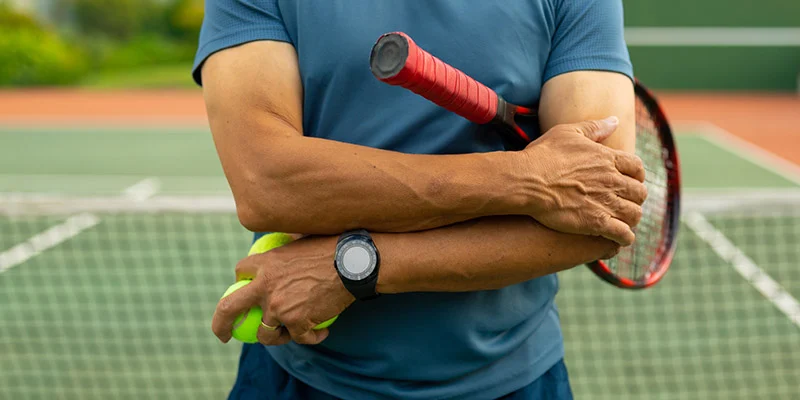
NON-SURGICAL Tennis Elbow Treatment in Raleigh / Cary NC
Tennis elbow, or lateral epicondylitis, is a painful condition of the elbow caused by overuse. Not surprisingly, playing tennis or other racquet sports can cause this condition. However, several other sports and activities can also put you at risk.
Tennis elbow is an inflammation of the tendons that join the forearm muscles on the outside of the elbow. The forearm muscles and tendons become damaged from overuse — repeating the same motions again and again. This leads to pain and tenderness on the outside of the elbow.
There are many treatment options for tennis elbow. In most cases, treatment involves a team approach. Primary doctors, physical therapists, and, in some cases, surgeons work together to provide the most effective care.
Wake Nonsurgical Ortho is Triangle’s first private practice solely dedicated to Nonsurgical orthopedics. Duke-trained non-surgical orthopedic specialist, Dr. Matthew Kanaan, is dedicated to making sure that patients receive access to non-surgical treatments for tennis elbow. Dr. Kanaan will take the time to answer any questions you may have so that he can determine the best treatment option for you. For more information, contact our orthopedic clinic in Raleigh at (919) 719-2270 and schedule an appointment today!
Anatomy
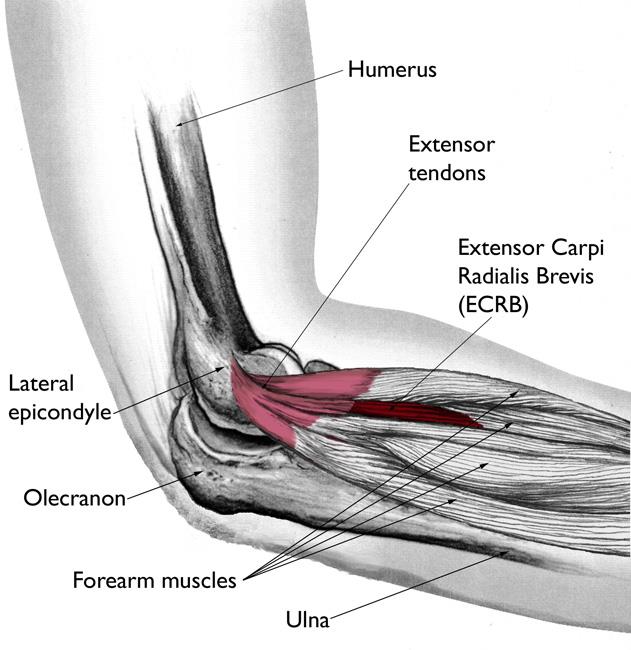
Your elbow joint is a joint made up of three bones: your upper arm bone (humerus) and the two bones in your forearm (radius and ulna). There are bony bumps at the bottom of the humerus called epicondyles. The bony bump on the outside (lateral side) of the elbow is called the lateral epicondyle.
The ECRB muscle and tendon is usually involved in tennis elbow. Reproduced and modified from The Body Almanac. © American Academy of Orthopaedic Surgeons, 2003.
Muscles, ligaments, and tendons hold the elbow joint together.
Lateral epicondylitis, or tennis elbow, involves the muscles and tendons of your forearm. Your forearm muscles extend your wrist and fingers. Your forearm tendons — often called extensors — attach the muscles to bone. They attach on the lateral epicondyle. The tendon usually involved in tennis elbow is called the Extensor Carpi Radialis Brevis (ECRB).
Cause
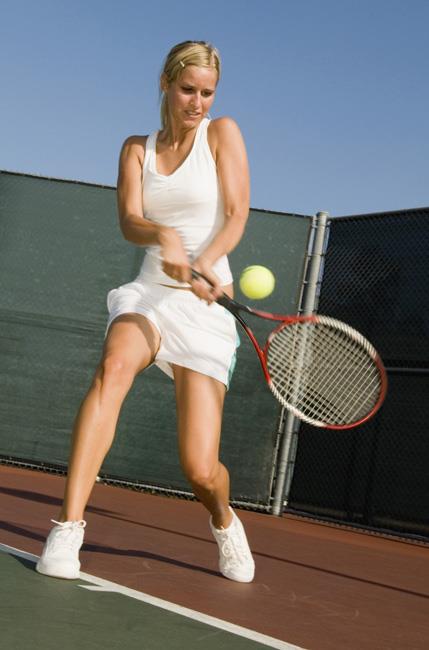
Recent studies show that tennis elbow is often due to damage to a specific forearm muscle. The extensor carpi radialis brevis (ECRB) muscle helps stabilize the wrist when the elbow is straight. This occurs during a tennis groundstroke, for example. When the ECRB is weakened from overuse, microscopic tears form in the tendon where it attaches to the lateral epicondyle. This leads to inflammation and pain.
The ECRB may also be at increased risk for damage because of its position. As the elbow bends and straightens, the muscle rubs against bony bumps. This can cause gradual wear and tear of the muscle over time.
Activities
Athletes are not the only people who get tennis elbow. Many people with tennis elbow participate in work or recreational activities that require repetitive and vigorous use of the forearm muscle.
Painters, plumbers, and carpenters are particularly prone to developing tennis elbow. Studies have shown that auto workers, cooks, and even butchers get tennis elbow more often than the rest of the population. It is thought that the repetition and weight lifting required in these occupations leads to injury.
Age
Most people who get tennis elbow are between the ages of 30 and 50, although anyone can get tennis elbow if they have the risk factors. In racquet sports like tennis, improper stroke technique and improper equipment may be risk factors.
Unknown
Lateral epicondylitis can occur without any recognized repetitive injury. This occurence is called “insidious” or of an unknown cause.
Symptoms
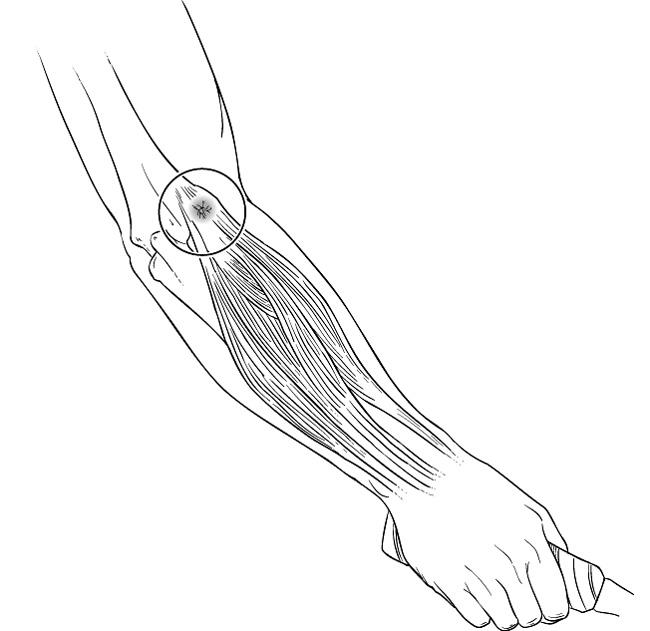
Location of pain in lateral epicondylitis. Reproduced from Griffen L (ed): Essentials of Musculoskeletal Care, Third Edition. © American Academy of Orthopaedic Surgeons, 2005.
The symptoms of tennis elbow develop gradually. In most cases, the pain begins as mild and slowly worsens over weeks and months. There is usually no specific injury associated with the start of symptoms.
Common signs and symptoms of tennis elbow include:
- Pain or burning on the outer part of your elbow
- Weak grip strength
The symptoms are often worsened with forearm activity, such as holding a racquet, turning a wrench, or shaking hands. Your dominant arm is most often affected; however both arms can be affected.
Doctor Examination
Your doctor will consider many factors in making a diagnosis. These include how your symptoms developed, any occupational risk factors, and recreational sports participation.
Your doctor will talk to you about what activities cause symptoms and where on your arm the symptoms occur. Be sure to tell your doctor if you have ever injured your elbow. If you have a history of rheumatoid arthritis or nerve disease, tell your doctor.
During the examination, your doctor will use a variety of tests to pinpoint the diagnosis. For example, your doctor may ask you to try to straighten your wrist and fingers against resistance with your arm fully straight to see if this causes pain. If the tests are positive, it tells your doctor that those muscles may not be healthy.
Tests
Your doctor may recommend additional tests to rule out other causes of your problem.
- X-rays. These tests provide clear images of dense structures like bone. They may be taken to rule out arthritis of the elbow.
- Magnetic resonance imaging (MRI) scan. If your doctor thinks your symptoms are related to a neck problem, an MRI scan may be ordered. MRIs scans show details of soft tissues, and will help your doctor see if you have a possible herniated disk or arthritis in your neck. Both of these conditions often produce arm pain.
- Electromyography (EMG). Your doctor may order an EMG to rule out nerve compression. Many nerves travel around the elbow, and the symptoms of nerve compression are similar to those of tennis elbow.
Non- Surgical Treatment
Surgery is not the only option when it comes to treating tennis elbow. Approximately 80% to 95% of patients have success with nonsurgical treatment. At Wake Sports Medicine in Raleigh , NC we offer a variety of non-surgical treatment options. We will fully evaluate the cause of the tennis elbow, and suggest a comprehensive plan to help the tendon heal faster. This may include:
Rest
The first step toward recovery is to give your arm proper rest. This means that you will have to stop participation in sports or heavy work activities for several weeks.
Non-steroidal anti-inflammatory medicines
Drugs like aspirin or ibuprofen reduce pain and swelling.
Physical therapy
Specific exercises are helpful for strengthening the muscles of the forearm. Your therapist may also perform ultrasound, ice massage, or muscle-stimulating techniques to improve muscle healing.
Brace
Using a brace centered over the back of your forearm may also help relieve symptoms of tennis elbow. This can reduce symptoms by resting the muscles and tendons.
Steroid injections
Steroids, such as cortisone, are very effective anti-inflammatory medicines. Your doctor may decide to inject the painful area around your lateral epicondyle with a steroid to relieve your symptoms.
Counterforce brace
The Counterforce Brace is used to help alleviate pain associated with tennis elbow. By transferring force to another location within your arm, this compression pad helps reduce tension and pain within your muscles and tendons.
Extracorporeal shock wave therapy
Shock wave therapy sends sound waves to the elbow. These sound waves create “microtrauma” that promote the body’s natural healing processes. Shock wave therapy is considered experimental by many doctors, but some sources show it can be effective.
Equipment check
If you participate in a racquet sport, your doctor may encourage you to have your equipment checked for proper fit. Stiffer racquets and looser-strung racquets often can reduce the stress on the forearm, which means that the forearm muscles do not have to work as hard. If you use an oversized racquet, changing to a smaller head may help prevent symptoms from recurring.
PRP Injections
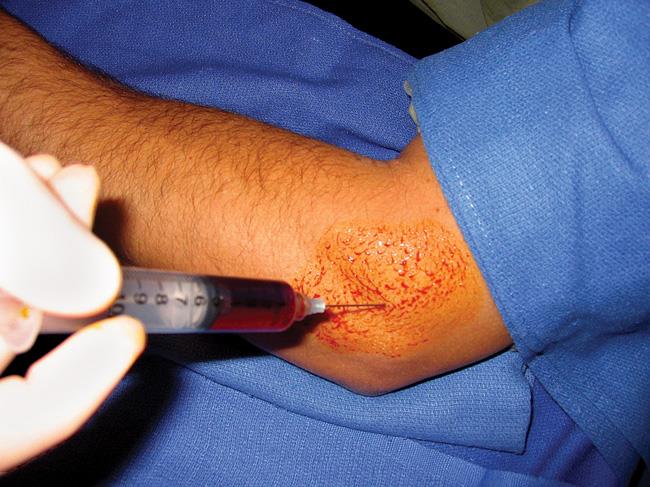
Platelet-rich plasma (PRP) is currently being investigated for its effectiveness in speeding the healing of a variety of tendon injuries. PRP is a preparation developed from a patient’s own blood. It contains a high concentration of proteins called growth factors that are very important in the healing of injuries.
Don’t wait! Contact us today to experience pain relief without the risk of surgery. Call (919) 719-2270, or schedule an appointment.
